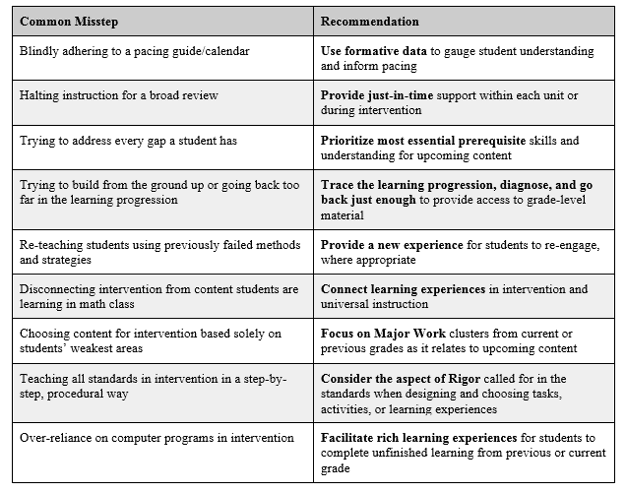
Explore classroom guidance, techniques, and activities to help you meet the needs of ALL students.



Discover new tools and materials to integrate into you instruction.



Find instructions and recommendations on how to adapt your existing materials to better align to college- and career-ready standards.



Learn what it means for instructional materials and assessment to be aligned to college- and career-ready standards.



Delve into new research and perspectives on instructional materials and practice.



Explore classroom guidance, techniques, and activities to help you meet the needs of ALL students.



Discover new tools and materials to integrate into you instruction.



Find instructions and recommendations on how to adapt your existing materials to better align to college- and career-ready standards.



Learn what it means for instructional materials and assessment to be aligned to college- and career-ready standards.



Delve into new research and perspectives on instructional materials and practice.



Avoid common pitfalls when it comes to supporting students with unfinished math learning
By: Astrid Fossum Posted: 11/01/17 01/17/19As teachers, we want to help all kids learn and when we’re faced with the realization that some students just aren’t “getting it,” we work to figure out how to catch kids up. It’s a prevalent struggle many educators grapple with and a frequent conversation in schools: How do we address unfinished learning in math and fill gaps in student understanding?
Over the course of my career I have seen, all too often, students behind grade level denied access to grade-level mathematics, in an effort to catch them up or “fill the holes.” All students deserve access to content-rich instruction at their grade level, and when students have unfinished learning from previous grades, teachers need to take appropriate action—and that doesn’t mean reverting solely to materials and content from previous grades.

So, how do we address unfinished learning and support students in developing understanding and mastery of content? Chrissy Allison, Director of Math Professional Learning at Achievement Network (ANet), and I were knee deep in conversations centered on unfinished learning when we first penned a “Do’s and Don’ts Chart” for catching kids up. The chart identifies some missteps districts, schools, and teachers make when working with students who have gaps in their math knowledge. We’ve included some recommendations to consider to avoid these missteps. You can download the chart at the top of this blog post.
Recommendations for Targeted Math and Intervention
Evidence of the Shifts in Mathematics are found in the Recommendations for Targeted Math and Intervention chart. When teachers plan universal instruction with Focus, Coherence, and Rigor in mind, but ignore these Shifts when it comes to intervention and support time, there is an immediate disconnect in instruction. The Shifts must be top of mind for both whole-class instruction and extra support. Let’s break a few of these down.
With Focus, intervention time should be based on the content that matters most for success in later mathematics. For instance, if a third grade student’s interim data illustrates weaknesses in two clusters: 3.G.A Reason with shapes and their attributes and 3. NF.A.1 Develop understanding of fractions as numbers, prioritize the fraction work since this reflects the Major Work of the Grade. Maintaining attention to Major Work of the Grade will ensure that additional time and attention is spent on foundational content necessary for students to be successful with future math work. When planning for Coherence, use the Coherence Map to trace content across the grades and design learning activities that support grade-level mathematics. Make connections explicit to students to support their developing thinking and understanding.
When planning for Coherence, use the Coherence Map to trace content across the grades and design learning activities that support grade-level mathematics. Make connections explicit to students to support their developing thinking and understanding. Remember that the standards themselves call for particular aspects of Rigor. Teaching tricks that proceduralize concepts and make ideas “quick and easy” for students undermines learning. Stay true to the aspect of Rigor in the standard and plan as such. For example, if intervening on 6.NS.B.2, Fluently divide multi-digit numbers using the standard algorithm, teach the standard algorithm and practice, practice, practice!
Remember that the standards themselves call for particular aspects of Rigor. Teaching tricks that proceduralize concepts and make ideas “quick and easy” for students undermines learning. Stay true to the aspect of Rigor in the standard and plan as such. For example, if intervening on 6.NS.B.2, Fluently divide multi-digit numbers using the standard algorithm, teach the standard algorithm and practice, practice, practice! The suggestions in the chart likely can’t all be tackled at one time. Determine where to start, what changes can be made, and how to move forward. It is important to consider interventions within the “big picture” of math education. This means taking a step back and applying the same principles you apply to your planning of whole-class instruction. At first, this may seem counterintuitive. It can be tempting to give in to gut reactions: “I need to address every gap, right now before I move on;” “I need to focus just on the unfinished learning—connecting grade-level content would just be confusing.” The reality is, however, that if we give in to these inclinations, we’re denying students access to grade-level content and Shifts-aligned instruction. And that isn’t fair to our students.
The suggestions in the chart likely can’t all be tackled at one time. Determine where to start, what changes can be made, and how to move forward. It is important to consider interventions within the “big picture” of math education. This means taking a step back and applying the same principles you apply to your planning of whole-class instruction. At first, this may seem counterintuitive. It can be tempting to give in to gut reactions: “I need to address every gap, right now before I move on;” “I need to focus just on the unfinished learning—connecting grade-level content would just be confusing.” The reality is, however, that if we give in to these inclinations, we’re denying students access to grade-level content and Shifts-aligned instruction. And that isn’t fair to our students.